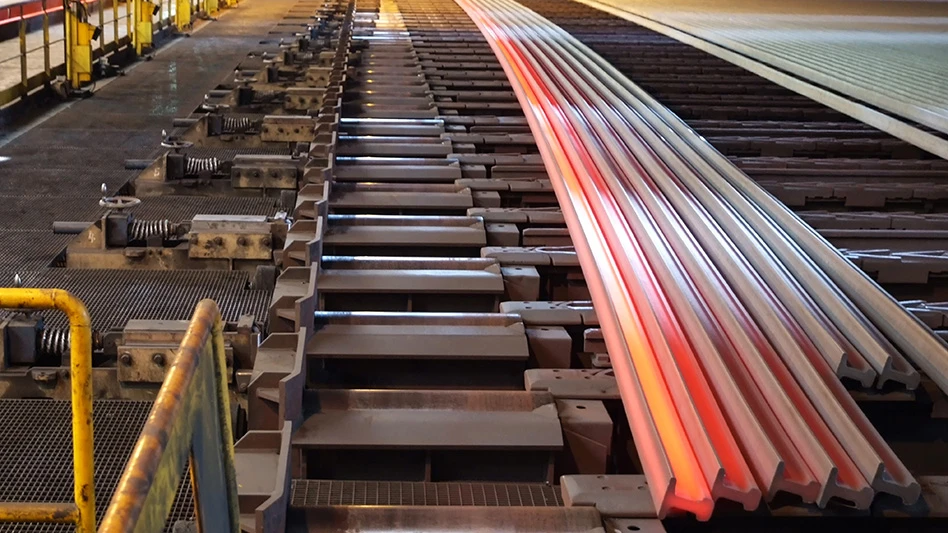
Photo courtesy of Saarstahl and Impetus.PR
Rail transport is already considered climate-friendly, according to Germany-based electric arc furnace (EAF) steelmaker Saarstahl Group, and the metals producer says recycled-content steel rail made at its EAF mill in France lowers passenger rail travel’s carbon footprint even further.
Working with Société Nationale des Chemins de Fer Français (SNCF), the state-owned railroad operator in France, the steelmaker says its Saarstahl Rail business unit has been successfully implementing a green rail concept in practice since 2019.
Additionally, Saarstahl says railroad network operators such as Belgian company Infrabel or infrastructure firms such as the Société du Grand Paris also have awarded Saarstahl Rail contracts for “green rails” worth millions of euros.
At its Saarstahl Ascoval EAF mill In Saint-Saulve in northern France, Saarstahl says its “sustainable production method,” including the use of nearly 100 percent recycled steel as feedstock, “are the keys to success for the decarbonized rails.”
Regarding circularity, Saarstahl says the French mill can melt up to 70 percent used rails as feedstock, depending on availability and the desired specifications.
Thus, Saarstahl Rail purchases used rails and steel scrap from rail network operators as it casts the rail scrap produced into blooms. The blooms are then transported by train to a Saarstahl Rail production facility in Hayange, France, where they are rolled to create the green rails.
Compared with steel rail produced via the blast furnace/basic oxygen furnace using iron ore and coal as raw materials, the recycled-content EAF method reduces carbon emissions up to 70 percent, Saarstahl says.
“Whereas 2.61 tons of CO2 are generally emitted per ton of [BOF] steel, this figure is reduced to just 0.77 tons per ton of steel with the new process,” the firm adds.
Cyrille Blard of rail operator SNCF says there were two key reasons behind the decision to place greater emphasis on development of sustainable products in the company’s procurement policy.
By procuring materials through a regional circular economy, one aim was to secure independence from geopolitical influences, such as those encountered during the COVID-19 pandemic or following Russia’s invasion of Ukraine.
The fact that the French government has issued a target to reduce carbon emissions by 25 percent by 2030 was the other key factor.
The Saarstahl loop, Blard says, “allows us to produce brand new materials from used custom materials, which represents a win for both sides of the life cycle.”
“SNCF Réseau [owner of SNCF] already greatly exceeded this target in 2022 with a reduction of 34 percent. The green rails made a significant contribution to this," Blard adds.
As part of a seven-year contract, SNCF Réseau is ordering around 130,000 tons of rails per year (more than 1,000 kilometers, or 620 miles, of railroad line) from Saarstahl Rail. In 2023, some 90 percent, or 125,000 tons, of these were considered “green” rails, which helped SNCF reduce its emissions by about 200,000 tons of CO2 equivalents.
Saarstahl Rail and SNCF say the project has deepened the cooperation between the two firms. “We engage in a very wide range of activities and hold regular meetings to discuss both technical and logistical questions,” says Dominique Chiesura, commercial director of Saarstahl Rail.
“This is a genuine partnership, which is precisely what we need for the new rails," Blard adds. "Saarstahl Ascoval requires used rails as raw material, while SNCF requires new green rails from Saarstahl Rail.
“We demonstrated that the recycled material in the green rails offers the same consistently high quality as new material.”
Another Saarstahl green rail project has involved Société du Grand Paris, operator of the Grand Paris Express megaproject (4 new metro lines) in the French capital, involving some 20,000 tons of green rails.
And 20,000 tons of Saarstahl green rails are now planned for use in the reconstruction of the destroyed rail network in western Ukraine.
Saarstahl says that by using low-CO2-emission steel, it is helping design sustainable mobility solutions for Europe and is constantly developing them further.
Latest from Recycling Today
- BMW Group, Encory launch 'direct recycling’ of batteries
- Loom Carbon, RTI International partner to scale textile recycling technology
- Goodwill Industries of West Michigan, American Glass Mosaics partner to divert glass from landfill
- CARI forms federal advocacy partnership
- Monthly packaging papers shipments down in November
- STEEL Act aims to enhance trade enforcement to prevent dumping of steel in the US
- San Francisco schools introduce compostable lunch trays
- Aduro graduates from Shell GameChanger program





